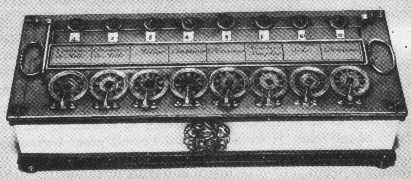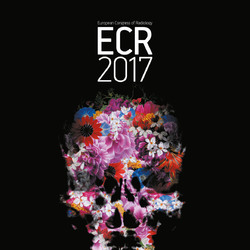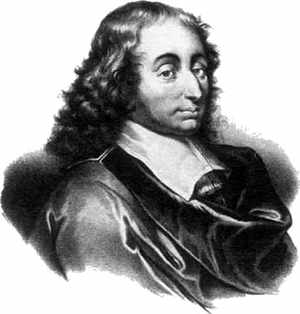Pascal’s calculator (Pascaline)
Pascal was only 19 years old, when he invented the oldest surviving mechanical calculator with an automatic decimal position carry out method. He created it to reduce some of the workload of his father, who was a tax comissioner in Rouen that time.

The numbers to add or subtract could be set by the small metal wheel dials on the top-front of the equipment, with the digit 0 through 9 displayed around the circumference of each wheel. To input a digit, the user placed a stylus in the corresponding spaces between the spokes, and turned the dial until a metal stop at the bottom was reached (similar to the way a rotary telephone dial is used). After finishing the input all the digits of the first number, one would simple redial the second number to be added, causing the sum of both numbers to appear in the small windows on the top-back. The mechanism included a weighted ratchet between the dials to push the next wheel in the row whenever there is a carry from the previous gear.
Since the wheels of the calculator only rotated in one direction, negative numbers could not be directly summed. To subtract one number from another, the method of nines’ components was used. To help the user, when a number was entered its nines’ component appeared in a window next to the above the original value.
Even multiplication was possible with Pascaline in a relative effective way, but division was a nightmare, performed by repeated subtractions.
Pascal constructed some 50 prototypes during his life and placed them in prominent locations throughout Europe. It was the first of its kind ever to be marketed.
Fortunately even today a few Pascal’s machines are in existence and working.
News
ECR 2017
 Pascal Team has exhibited it’s complete range of digital X-ray systems in ECR2017, the largest radiological meeting in Europe. More than 20.000 participants from over 100 countries visited the scientific and educational programme, and the related technical exhibition this year. Exhibitors from all over the world presented the results of their latest researches and developments.
Pascal Team has exhibited it’s complete range of digital X-ray systems in ECR2017, the largest radiological meeting in Europe. More than 20.000 participants from over 100 countries visited the scientific and educational programme, and the related technical exhibition this year. Exhibitors from all over the world presented the results of their latest researches and developments.
The inspiration of our company name
Blaise Pascal
 Blaise Pascal, the prominent French
scientist was born in Clemont-Ferrand in 1623. He contributed significally in the
fields of mathematics, physics, philosophy and theology as well.
Blaise Pascal, the prominent French
scientist was born in Clemont-Ferrand in 1623. He contributed significally in the
fields of mathematics, physics, philosophy and theology as well.
In honor of his intellectual curiosity and diligence, assiduous and successful simultaneous work in different areas of science, we treat him as our model and have chosen his name for our company. ....
